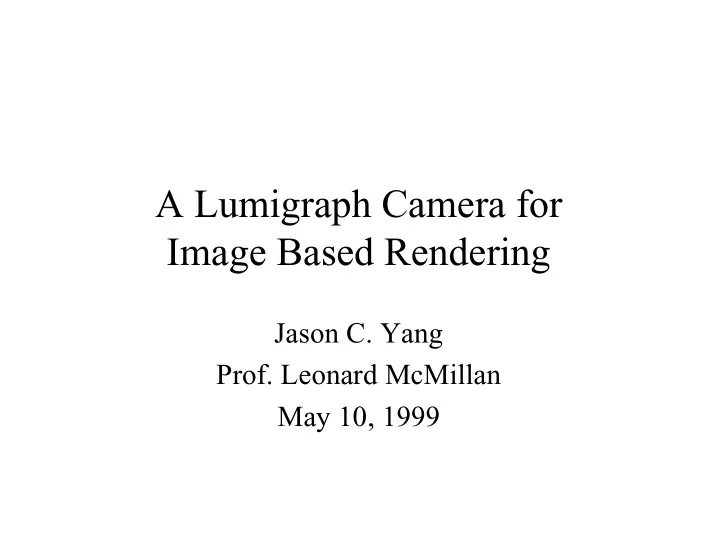

A Lumigraph Camera for Image Based Rendering Jason C. Yang Prof. Leonard McMillan May 10, 1999
Overview • Image Based Rendering • Video Demo • System Design • Obstacles
Image Based Rendering • Motivation - Geometry is hard. - Textures are easy. • Light Field Rendering: Generate novel views using a database of “rays” from a 2D array of images.
State-of-the-art in CG Model Model + Shading Model + Shading + Textures At what point do things start looking real?
Rendering Process new viewpoint
Demo System
Goals • Real Time Camera System • Off the shelf components • Desired frame rate: 30 frames per second 640 x 480 resolution
Overall Design Sensor B A B Pod - A FIFO Address Interface Solution C D C D FIFO Data (PCI or Cardbus) A B A B C D C D Motherboard
Sensor Pod Address Data Address Aramis Random Access CLK CMOS Sensor (on board A/D) FPGA Data Logic VRAM (for FPN)
Sensor Pod Data Address CMOS Sensor CLK (on board A/D) FPGA Logic Data VRAM Address
Major Hurdle • Ideal frame rate is not achievable -Best Frame rate: 7fps • Bottlenecks: - PCI bus - Turnaround time for one pixel • Potential Solution: - Interleaving - FIFOs
Actual Frame Rate • To reach desired 30fps we need: 37MBs • Maximum Random Access on PCI: 33MBs CLK Address/ Turn Data Wait Address Data Around 30ns • Turn around time (time to access pixel from camera) is not one clock cycle!
Virtual vs. Physical Pixels When the host requests a pixel 0,2 1,2 it is actually a virtual pixel as indicated by the circles. Green Red Green 0,1 1,1 2,1 The actual pixels requested are Blue Green Blue the color photocells on the imager. 0,0 1,0 2,0 Green Red Green Each virtual pixel request will return a four byte group of color values.
Time to Access a Pixel CLK Y0 X0 X1 Y1 X2 X3 Address A/D A/D A/D A/D A/D Data (Y0,X0) (Y0,X1) (Y1,X2) (Y1,X3) 30ns 480ns 4 byte Pixel ready
Actual Transfer Rate CLK Address/ Turn Data Wait Address Data Around 30ns <Address> + <Access> + <Data> + <Wait> = 540ns 30ns + 450ns + 30ns + 30ns 540ns/pixel => 7fps @ 640x480
Optimizations Sensor Sensor Sensor Sensor Pod - A Pod -A Pod -A Pod -A Sensor Sensor Sensor Sensor Pod - B Pod - B Pod - B Pod - B Mux/ Address Logic Mux/ Logic 32 bit Motherboard - Interleaving Data
Use PCI Burst Mode • PCI burst mode can achieve 133MBs CLK Address/ Turn Data Data Data Address Data Around 30 ns • Idea: Use FIFOs to store Addresses and Data
Conclusion • Tradeoffs • Technological Needs - Random Access CMOS imagers - Faster imagers - Faster bus protocols
Recommend
More recommend